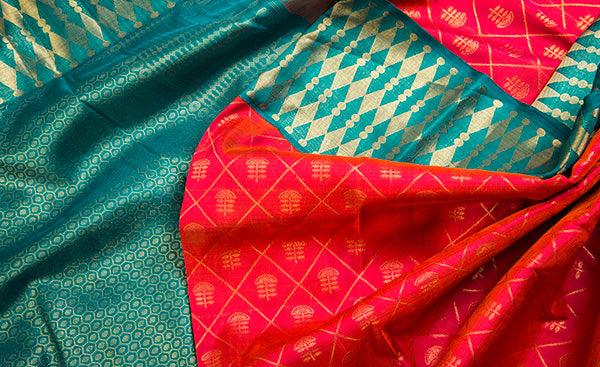 Image Source: Palam Silks
Image Source: Palam Silks
India's textile heritage is interwoven with gold threads-literally and figuratively. The recent announcement, "Stitch of Gold: Weaving Heritage into Luxury," brings to center stage the timeless heritage and modern-day resurgence of ancient crafts such as Kanchipuram silk sarees and Zardozi embroidery. These traditions, once the exclusive domain of royalty, are now being reinterpreted for the global luxury market, integrating centuries-old techniques with cutting-edge aesthetics to produce heirloom-quality pieces that honor both heritage and luxury.
Reviving Ancient Techniques
-
Kanchipuram sarees and Zardozi embroidery are famous for the application of silk and actual gold or silver thread, encapsulating centuries of Indian craftsmanship.
-
Zardozi, which is derived from Persian terms for "gold" and "sewing," consists of elaborate metal embroidery on silk, satin, or velvet and is frequently decorated with pearls and precious stones.
-
These arts have been followed from the Rig Vedic era, with historical accounts documenting their application in royal clothing and temple adornments.
Symbolism and Cultural Significance
-
Every fiber of a Kanchipuram saree or Zardozi work is woven with the essence of a people, symbolizing dedication to beauty, heritage, and cultural pride.
-
Conventional designs tend to be inspired by Persian art, including floral and vine motifs that signify prosperity and perpetuation.
-
Zardozi and Kanchipuram fabrics were traditionally employed for adorning the clothes of gods, kings, and nobility, highlighting their role as symbols of luxury and sanctity.
Contemporary Adaptations and Affordability
-
Although pure gold and silver were the norm earlier, contemporary craftsmen tend to employ copper wire given a golden or silver sheen, rendering these arts affordable without compromising on aesthetic grandeur.
-
Contemporary designers are blending traditional techniques with modern designs, making heritage textiles relevant for new generations of luxury consumers.
Preservation and Legacy
-
The preservation of these crafts is not just about maintaining a decorative tradition, but about carrying forward a legacy of intricate artistry and cultural significance.
-
Marketplaces like Old Delhi’s Kinari Bazar and specialty emporiums continue to offer authentic Zardozi and Kanchipuram pieces, supporting artisans and sustaining the craft.
Luxury Redefined
"Stitch of Gold" illustrates the way luxury can be grounded in heritage, with every item being a testament to the creative genius and eternal beauty of India's textile arts.
These heirloom pieces are marketed as both fashion statements and cultural artifacts, appealing to sophisticated buyers who crave exclusivity and significance in their luxury buys.
Relevant Sources: Today's Traveller, ANI News, YouTube, Instagram
Advertisement
Advertisement






